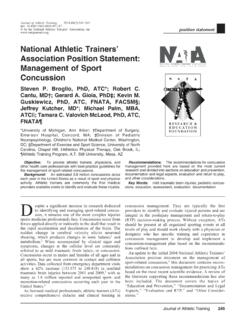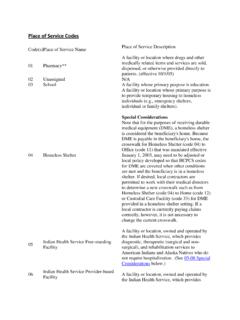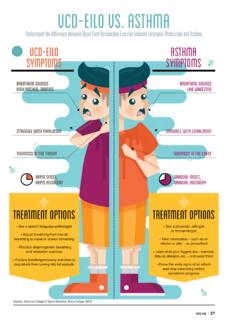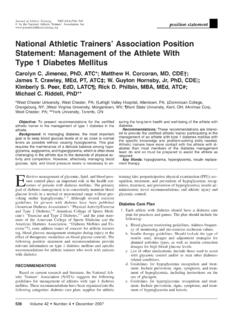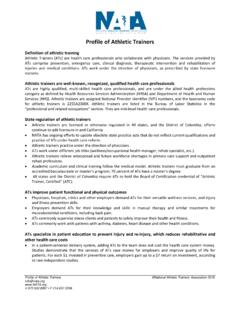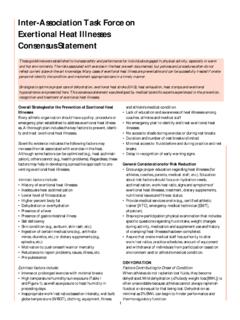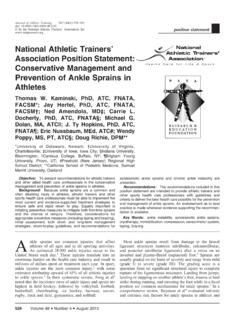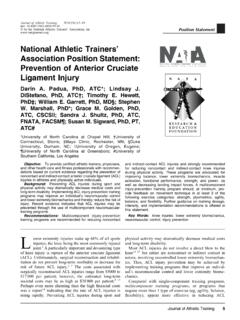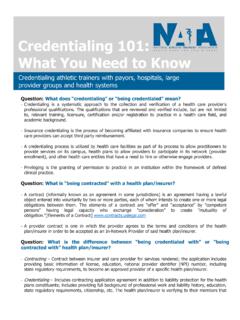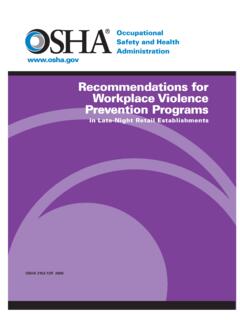Transcription of National Athletic Trainers' Association Position Statement ...
1 Journal of Athletic Training99 Journal of Athletic Training2002;37(1):99 104qby the National Athletic Trainers Association , Athletic Trainers AssociationPosition Statement : Emergency Planningin AthleticsJ. C. Andersen*; Ronald W. Courson ; Douglas M. Kleiner ;Todd A. McLoda *Armstrong Atlantic State University, Savannah, GA; University of Georgia, Athens, GA; University of Florida,Health Science Center/Jacksonville, Jacksonville, FL; Illinois State University, Normal, ILJ. C. Andersen, PhD, ATC, PT, SCS, contributed to conception and design; acquisition and analysis and interpretation of thedata; and drafting, critical revision, and final approval of the article.
2 Ronald W. Courson, ATC, PT, NREMT-I, CSCS, DouglasM. Kleiner, PhD, ATC, CSCS, NREMT, FACSM, and Todd A. McLoda, PhD, ATC, contributed to acquisition and analysis andinterpretation of the data and drafting, critical revision, and final approval of the correspondence to National Athletic Trainers Association , Communications Department, 2952 Stemmons Freeway,Dallas, TX :To educate Athletic trainers and others about theneed for emergency planning, to provide guidelines in the de-velopment of emergency plans, and to advocate documentationof emergency :Most injuries sustained during athletics or oth-er physical activity are relatively minor.
3 However, potentiallylimb-threatening or life-threatening emergencies in athletics andphysical activity are unpredictable and occur without management of these injuries is critical and should becarried out by trained health services personnel to minimize riskto the injured participant. The organization or institution and itspersonnel can be placed at risk by the lack of an emergencyplan, which may be the foundation of a legal :The National Athletic Trainers Associ-ation recommends that each organization or institution thatsponsors Athletic activities or events develop and implement awritten emergency plan.
4 Emergency plans should be developedby organizational or institutional personnel in consultation withthe local emergency medical services. Components of theemergency plan include identification of the personnel involved,specification of the equipment needed to respond to the emer-gency, and establishment of a communication system to sum-mon emergency care. Additional components of the emergencyplan are identification of the mode of emergency transport,specification of the venue or activity location, and incorporationof emergency service personnel into the development and im-plementation process. Emergency plans should be reviewedand rehearsed annually, with written documentation of anymodifications.
5 The plan should identify responsibility for docu-mentation of actions taken during the emergency, evaluation ofthe emergency response, institutional personnel training, andequipment maintenance. Further, training of the involved per-sonnel should include automatic external defibrillation, cardio-pulmonary resuscitation, first aid, and prevention of Words:policies and procedures, athletics, planning, cat-astrophicAlthough most injuries that occur in athletics are rela-tively minor, limb-threatening or life-threatening in-juries are unpredictable and can occur without of the relatively low incidence rate of cata-strophic injuries, Athletic program personnel may develop afalse sense of security over time in the absence of such 4 However, these injuries can occur during any physicalactivity and at any level of participation.
6 Of additional concernis the heightened public awareness associated with the natureand management of such injuries. Medicolegal interests canlead to questions about the qualifications of the personnel in-volved, the preparedness of the organization for handling thesesituations, and the actions taken by program emergency management of limb- or life-threateninginjuries is critical and should be handled by trained medicaland allied health 4 Preparation for response toemergencies includes education and training, maintenance ofemergency equipment and supplies, appropriate use of person-nel, and the formation and implementation of an emergencyplan.
7 The emergency plan should be thought of as a blueprintfor handling emergencies. A sound emergency plan is easilyunderstood and establishes accountability for the managementof emergencies. Furthermore, failure to have an emergencyplan can be considered STATEMENTB ased on an extensive survey of the literature and expertreview, the following is the Position of the National AthleticTrainers Association (NATA):1. Each institution or organization that sponsors Athletic ac-tivities must have a written emergency plan. The emer-gency plan should be comprehensive and practical, yetflexible enough to adapt to any emergency Emergency plans must be written documents and shouldbe distributed to certified Athletic trainers, team and at-100 Volume 37 Number 1 March 2002tending physicians, Athletic training students, institutionaland organizational safety personnel , institutional and or-ganizational administrators, and coaches.
8 The emergencyplan should be developed in consultation with local emer-gency medical services An emergency plan for athletics identifies the personnelinvolved in carrying out the emergency plan and outlinesthe qualifications of those executing the plan. Sports med-icine professionals, officials, and coaches should betrained in automatic external defibrillation, cardiopulmo-nary resuscitation, first aid, and prevention of The emergency plan should specify the equipment neededto carry out the tasks required in the event of an emer-gency. In addition, the emergency plan should outline thelocation of the emergency equipment.
9 Further, the equip-ment available should be appropriate to the level of train-ing of the personnel Establishment of a clear mechanism for communication toappropriate emergency care service providers and identi-fication of the mode of transportation for the injured par-ticipant are critical elements of an emergency The emergency plan should be specific to the activity ven-ue. That is, each activity site should have a defined emer-gency plan that is derived from the overall institutional ororganizational policies on emergency Emergency plans should incorporate the emergency carefacilities to which the injured individual will be receiving facilities should be notified in ad-vance of scheduled events and contests.
10 personnel fromthe emergency receiving facilities should be included inthe development of the emergency plan for the institutionor The emergency plan specifies the necessary documenta-tion supporting the implementation and evaluation of theemergency plan. This documentation should identify re-sponsibility for documenting actions taken during theemergency, evaluation of the emergency response, and in-stitutional personnel The emergency plan should be reviewed and rehearsedannually, although more frequent review and rehearsalmay be necessary. The results of these reviews and re-hearsals should be documented and should indicate wheth-er the emergency plan was modified, with further docu-mentation reflecting how the plan was All personnel involved with the organization and spon-sorship of Athletic activities share a professional respon-sibility to provide for the emergency care of an injuredperson, including the development and implementation ofan emergency All personnel involved with the organization and spon-sorship of Athletic activities share a legal duty to develop,implement.
